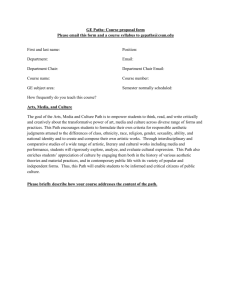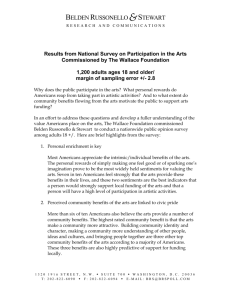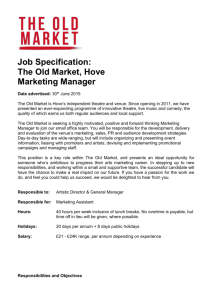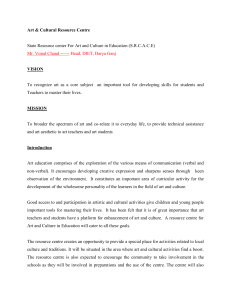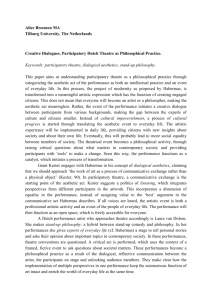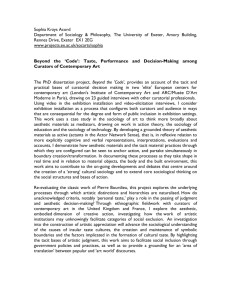Presentation
advertisement
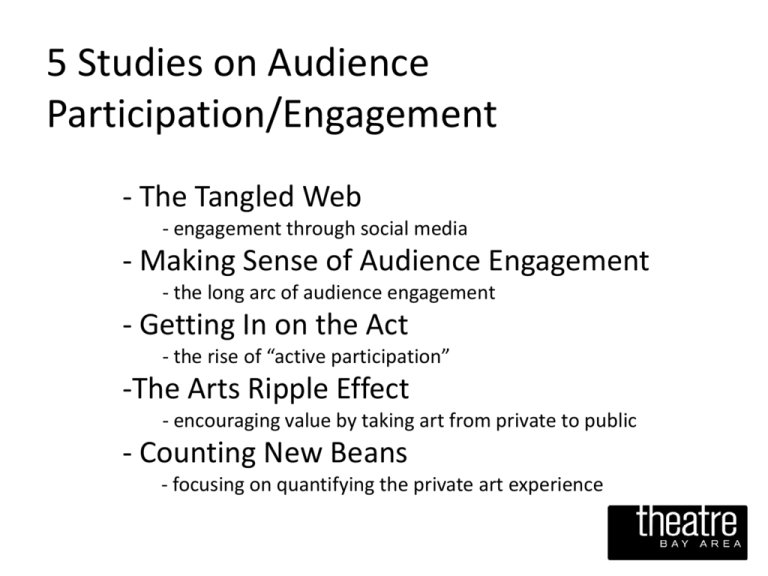
5 Studies on Audience Participation/Engagement - The Tangled Web - engagement through social media - Making Sense of Audience Engagement - the long arc of audience engagement - Getting In on the Act - the rise of “active participation” -The Arts Ripple Effect - encouraging value by taking art from private to public - Counting New Beans - focusing on quantifying the private art experience By Devon V. Smith Edited by Clayton Lord Commissioned by Theatre Bay Area with funds from the Wallace Foundation, Grants for the Arts, the San Francisco Foundation, the William and Flora Hewlett Foundation and the Koret Foundation What is it? 207 nonprofit organizations Multi-genre Multi-budget Geographically diverse Varying levels of social media expertise Attempting to lay out a baseline for social media engagement by arts organizations, and to highlight bright spots and best practices for the field. Where is it? Research report: http://www.theatrebayarea.org/datapoint Contact: clay@theatrebayarea.org On average: 3 social networks 66 pieces of content/month 162 user responses in return 99% of orgs active on at least 1 social network in study period % of orgs active within study period Foursquare 17% Blog 28% Flickr 30% Yelp 33% YouTube 59% Twitter 64% Tweet 91% 0% 10% 20% 30% 40% 50% 60% 70% 80% 90% 100% Bright spots: Facebook: Update multiple times/day, custom URL, feature a Welcome tab. Twitter: Update 4x+/day, do not auto-update from Facebook. YouTube: Update 1x+/week. median monthly activity/arts org YouTube Videos Uploaded 1 Blog Posts 4 Facebook Posts 17 Flickr Photos Uploaded 20 Twitter Tweets 24 0 5 10 15 20 25 30 average FB likes by update frequency 5,000 4,000 3,000 2,000 1,000 0 Multiple Daily Daily Weekly Monthly average FB comments/post by update frequency 7 6 5 4 3 2 1 0 Multiple Daily Daily Weekly Monthly average Twitter followers by update frequency 7000 6000 5000 4000 3000 2000 1000 0 4x+/day 2-4x/day Every other day-2x/day Less than every other day 0 average @ mentions by update frequency 50 45 40 35 30 25 20 15 10 5 0 4x+/day 2-4x/day Every other day-2x/day Less than every other day 0 Arts organizations blogging on a self-hosted platform 2x/week or more have more subscribers and comments/post than otherwise. value of a self-hosted blog 20 18 16 14 12 10 8 6 4 2 0 Posts Subscribers Self-hosted Blogspot/Wordpress Comments By Alan Brown and Rebecca Ratzin Commissioned by the San Francisco Foundation, Grants for the Arts and the Wallace Foundation What is it? “This report takes stock of a growing body of practice in the arts sector referred to as ‘audience engagement’.” Attempts to understand and refine the wide array of “engagement” programs into an “Arc of Engagement” to understand the audience’s experience over time. Where is it? Research report: http://www.wolfbrown.com Audience engagement: “a guiding philosophy in the creation and delivery of arts experiences in which the paramount concern is maximizing the impact on the participant.” The Arc of Engagement: “a five-stage process through which audiences pass, including build-up and contextualization, the artistic exchange, post-processing and extended impact echo.” 6 Audience Typologies with respect to Engagement - Readers - Critical Reviewers - Casual Talkers - Technology-based Processors - Insight Seekers - Active Learners By Alan Brown and Jennifer Novak-Leonard, in partnership with Shelly Glibride Commissioned by the James Irvine Foundation What is it? “This report aims to illuminate a growing body of practice around participatory engagement and dispel some of the anxiety surrounding this sphere of activity.” Written in conjunction/to support the Irvine Foundation’s new granting strategy, which highly favors “participatory arts practice.” Where is it? Research report: http://www.irvine.org Participatory Arts Practice: “various forms of arts participation in which people play an expressive role.” Arts Engagement: “the entire spectrum of ways that people can be involved in the arts.” “General population studies of arts participation consistently find that active participants are more likely to be audience members in the conventional sense.” Variations on participatory art programs: -Audience-based programs - main focus on consumption of an artistic product - Participant-based programs - main focus on the process of artistic creation Intended goals/outcomes of participatory arts programs: - In Service of Community Need - Programs designed around specific goals of social justic, activism or giving voice to the disenfranchised. - In Support of Artistic Vision - Mission-driven but not connected to core programming. Usually the process of participating is more important than the artistic outcome. - In Service of Artistic Process/Product - Audiences are allowed to co-create or actually create art. - As the Fundamental Goal - Participation is paramount, product is secondary. What is it? Year-long investigation into what arguments for public support of the arts work and what arguments don’t. Posits that the best messaging around the arts are that a thriving arts sector creates “ripple effects” of benefits throughout the community. Produced by the Topos Partnership Commissioned by Fine Arts Fund (now ArtsWave) with funds from Carol Ann and Ralph V. Haile Jr./US Bank Foundation and the Greater Cincinnati Foundation. Where is it? Research report: http://www.fineartsfund.org Contact: mwaller@fineartsfund.org “Public responsibility for the arts is undermined by deeply entrenched perceptions that have nothing to do with government and everything to do with understanding of the arts.” Assumptions of the public that work against the objective of positioning the arts as a public good: -The arts are a private matter - The arts are a good to be purchased - People expect to be passive, not active - The arts are a low priority Objective: to create a “sense of broadly shared responsibility for the arts” in the community. The “Ripple Effect” - Useful in highlighting the “vibrant, thriving economy” that comes from artistic investment - Showcases the more “connected population” that emerges from shared arts experiences 1) Surveying the landscape - The arts as entertainment - The arts as personal expression - The arts as beauty - The arts as a school subject 2) Which lead to these consequences: - The arts are a private matter - The arts are a good to be purchased - The arts are passive, not active - The arts are a low priority 3) Changing the landscape (moving from problematic understandings to constructive ones) - The arts exhibit community beliefs - The arts are a public concern - The arts are necessary - The arts are everywhere - Arts opportunities are active and clear - The arts are emotional and practical “The arts create ripple effects of benefits throughout our community.” Approaches that Missed the Mark with Focus Groups - Civic inspiration (great civilizations always have art) - Great cities (great cities always invest in art) - Health/science (science says art makes you healthier) - Broadening our horizons (art’s benefits are unique) - Human universal (art has always been a basic need) - City planning (cities need art to prosper) - Innovation (art inspires creativity and innovation) - Works of beauty (human spirit needs beauty) - Transcendence (takes us away from the everyday) - Kids (art engenders empathy and problem-solving) - House/Home (art turns a “house” into a “home”) “Measuring the Intrinsic Impact of Live Theatre” By Alan Brown and Rebecca Ratzkin Edited by Clayton Lord Commissioned by Theatre Bay Area with funds from the Doris Duke Charitable Foundation, the NEA, the Mellon Foundation, the Pew Center for Arts & Heritage, Theatre Development Fund, Arts Midwest, San Francisco Arts Commission, City of San Jose and others What is it? 58 productions 18 theatres 6 cities 60,000 surveys out 19,000 surveys back Attempting to measure the intellectual, emotional, social, and empathetic impact of art on an individual using standard metrics and a common vocabulary. Where is it? Book: http://www.theatrebayarea.org/intrinsicimpact WolfBrown research report: http://www.intrinsicimpact.org Contact: clay@theatrebayarea.org High response rates (45% on average) suggest theatre patrons are aching to give meaningful feedback. Select Impact Indicators - Subscribers vs. Single Ticket Buyers Single Ticket Buyers Social Bonding (Celebrate my Identity) Captivation: Absorbed 4.5 4.0 Subscribers Captivation: Felt Involved as an Audience Member 3.5 Social: Sense of Connectedness Emotion: Overall Strength of Response 3.0 2.5 2.0 Aesthetic: Will Follow an Artist Emotion: Feelings of Empathy 1.5 1.0 Emotion: Felt Emotionally Charged Aesthetic Validation Aesthetic: Explosed to New Art Intellectual: Gained New Insight Intellectual: Reflect on Own Opinions Intellectual: Eyes Opened to a New Idea Motivations for Attending, by Age Cohort 60% 50% To relax or escape To be emotionally moved or inspired 40% To revisit a familiar work or artist 30% To spend quality time with family members To see the work of a specific actor or director 20% Because someone invited you For work or educational purposes 10% 0% 15-24 25-34 35-44 45-54 55-64 65-74 75+ Incidence of Participating in Post-Performance Engagement Activities, by Age Cohort 70% 60% Email or speak to friend 50% Reflect privately 40% Read program book Search for info online 30% React online or thru social media 20% Attend a post-performance discussion 10% 0% 15-24 25-34 35-44 45-54 55-64 65+ Age Cohorts - Ticket Type Subscribers Single Ticket Buyers 87% 90% 70% 70% 75% 81% 80% 60% 63% 60% 51% 49% 50% 37% 40% 40% 25% 13% 19% 20% 10% 30% 30% 0% 15-24 (2% of sample) 25-34 (5% of sample) 35-44 (7% of sample) 45-54 (16% of sample) 55-64 (30% of sample) 65-74 (26% of sample) 75+ (14% of sample) Key Impact Results, by Decision-Making Role My decision My spouse or partner's decision Captivation: Absorbed Social: Sense of Connectedness 4.5 4.0 Captivation: Awed by Skill & Artistry 3.5 3.0 Aesthetic: Will Follow an Artist Captivation: Felt Involved as an Audience Member 2.5 2.0 1.5 1.0 Emotion: Overall Strength of Response Aesthetic Validation Aesthetic: Explosed to New Art Emotion: Feelings of Empathy Intellectual: Reflect on Own Opinions Intellectual: Gained New Insight 25% of people said they did anything to “prepare.” But 30-40% said they read a preview or review. Major form of preparation: Wikipedia. 35% of people said they left with unanswered questions. 98% of those people actually wrote down their questions. Causal model of impact (“How absorbed were you…?”) Correlation=.34; R Square=.16 Anticipation Correlation = .40; R Square = .16 (“How much were you looking forward to this performance?”) R Square = .13 Correlation=.70; R Square=.48 Correlation=.39; R Square=.15 Summative Impact (“Future Impression” Indicator) Correlation = .52; R Square = .28 Familiarity, Preparation, and Feeling Welcome Start Here Repeat Attendance? PostPerformance Engagement Loyalty (Likelihood to Recommend) Implied Relationship Captivation Thank you!

